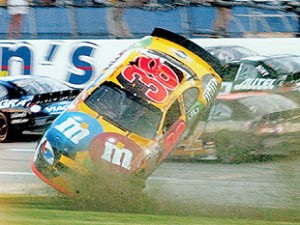Gamecock Fanatics
You are using an out of date browser. It may not display this or other websites correctly.
You should upgrade or use an alternative browser.
You should upgrade or use an alternative browser.
Countdown to Kickoff
- Thread starter Swayin
- Start date
USS Shangri-La, CV-38.
_underway_in_the_Pacific_Ocean,_17_August_1945_(80-G-278827).jpg/1280px-USS_Shangri-La_(CV-38)_underway_in_the_Pacific_Ocean,_17_August_1945_(80-G-278827).jpg)
_underway_in_the_Pacific_Ocean,_17_August_1945_(80-G-278827).jpg/1280px-USS_Shangri-La_(CV-38)_underway_in_the_Pacific_Ocean,_17_August_1945_(80-G-278827).jpg)
https://en.wikipedia.org/wiki/USS_Shangri-LaNomenclature
The naming of the ship was a radical departure from the general practice of the time, which was to name aircraft carriers after battles or previous US Navy ships. After the Doolittle Raid, launched from the aircraft carrier Hornet, President Roosevelt answered a reporter's question by saying that the raid had been launched from "Shangri-La", the fictional faraway land of the James Hilton novel Lost Horizon.
Construction and commissioning
Shangri-La was one of the "long-hull" Essex-class ships. She was laid down by the Norfolk Navy Yard, at Portsmouth, Virginia, on 15 January 1943, and was launched on 24 February 1944, sponsored by Josephine Doolittle (wife of Jimmy Doolittle). Shangri-La was commissioned on 15 September 1944, with Captain James D. Barner in command.
Last edited by a moderator:
USS Daniel T. Griffin, APD-38. Formerly DE-54.
,_circa_in_1944.jpg)
,_circa_in_1944.jpg)
https://en.wikipedia.org/wiki/USS_Daniel_T._Griffin_(DE-54)USS Daniel T. Griffin (DE-54/APD-38), a Buckley-class destroyer escort of the United States Navy, was named in honor of Ordnanceman Daniel T. Griffin (1911–1941), who was killed in action during the Japanese attack on the Hawaiian Islands.
Namesake
Daniel Thornburg Griffin was born on 25 March 1911 in Allendale, Illinois. He enlisted in the Navy on 6 October 1930 and served continuously until his death in his PBY Catalina during the Japanese Attack on Pearl Harbor on 7 December 1941. Aviation Machinist's Mate First Class Griffin was cited by Commander-in-Chief, Pacific Fleet, for his prompt and efficient action and his utter disregard of personal danger in the defense of Naval Air Station Kaneohe Bay. He was first buried in Hawaii in December 1941 and was reinterred in Colorado Springs in October 1947.
Construction and commissioning
Daniel T. Griffin was launched on 25 February 1943 by the Bethlehem-Hingham Shipyard, Hingham, Massachusetts, sponsored by Mrs. D. T. Griffin, and commissioned on 9 June with Lieutenant-Commander P. M. Fenton, of the USNR, in command.
Last edited by a moderator:
Don't Be That Way by Benny Goodman and his Swing band was the #1 song in the country for five weeks from March to May of 1938. Interesting background on the famed Carnegie Hall concert by Benny Goodman.
"There were two copies of the recordings: one for me and one for the Library of Congress." LOL
"There were two copies of the recordings: one for me and one for the Library of Congress." LOL
Last edited by a moderator:
Benny Goodman and his band performing Sing, Sing, Sing during the 1938 concert at Carnegie Hall. Harry James on trumpet and Gene Krupa on drums. Enough said.
Last edited by a moderator:
Big George with the Saints.
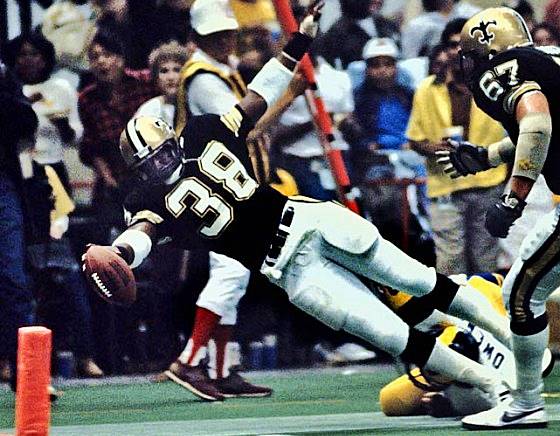

https://www.saintshalloffame.com/inductees/373/When he was the head coach of the Houston Oilers, Bum Phillips had the best running back, if not the best running game in the NFL with Earl Campbell. When Phillips became head coach of the New Orleans Saints, he wanted to follow the blueprint for success that he enjoyed in Houston. As a result, Phillips passed on Lawrence Taylor and drafted South Carolina star George Rogers with the No. 1 overall pick in the 1981 NFL Draft. While Taylor went on to be arguably the best linebacker, if not the best defensive player in NFL history, Rogers was a good pick and made his mark instantly, dramatically. The Heisman Trophy winner led the NFL in rushing in his rookie season with 1,674 yards, an all-time high for an NFL rookie, and scored 13 touchdowns. The 1,674 yards are still a franchise best for a single season. Rogers earned Rookie of the Year and first-team All-Pro honors and a Pro Bowl berth. He backed it up with another Pro Bowl berth in 1982 before unleashing another outstanding season in 1983 with 1,144 yards and five touchdowns, ranking 10th in the league in rushing yards.
Despite playing just four seasons in New Orleans, Rogers still ranks second all-time in franchise history in rushing with 995 carries for 4,267 yards and 23 touchdowns. He led the Saints in rushing in all four seasons with New Orleans. He had 16 games of 100 or more yards rushing in his 51 games played for the Saints. Greatest Moment: The Saints opened the 1983 season on Sept. 4 at home in the Louisiana Superdome against the St. Louis Cardinals. The Saints won 28-17, thanks to Rogers. The third-year running back rushed 24 times for a career-best 206 yards and two touchdowns, including a 76-yard dash early in the third quarter that gave the Saints a 14-10 lead, one they would not relinquish. He added a one-yard score later in the quarter. Honors: Rogers was inducted into the Saints Hall of Fame in 1992. He was named first team All-Pro in 1981 and earned Pro Bowl honors in 1981 and 1982.
Last edited by a moderator:
Big George with the Redskins.
:format(webp)/cdn.vox-cdn.com/uploads/chorus_image/image/56037045/279808.0.jpg)
The poll results on the link say it all about Big George.
Sa-lute!
:format(webp)/cdn.vox-cdn.com/uploads/chorus_image/image/56037045/279808.0.jpg)
https://www.hogshaven.com/2017/8/3/16090562/redskins-by-the-jersey-numbers-38-george-rogersWhen you consider the complete list of players who’ve donned #38 for the burgundy and gold, a few names seem to jump to the forefront. One is of a current player who, since he entered the NFL last season, has impressed coaches and has the potential to become a great #38: Kendall Fuller.
The greatest #38, however, has to be the one who helped the Redskins on their path to their 1987 Super Bowl win. That player is George Rogers.
The Heisman Trophy winner was selected with the first overall pick by the New Orleans Saints in the 1981 NFL Draft. In his first four years, all with the Saints, he earned Offensive Rookie of the Year honors (1981), was selected to the Pro Bowl twice (1981, 1982), and led the league in rushing attempts, rushing yards, and rushing yards/game (1981).
It wasn’t until Rogers headed to D.C. that he would earn what he calls “the highlight of [his] football career.” In 1986, Rogers racked up accomplishments on the field as the Redskins marched toward the Super Bowl. He led the league in rushing touchdowns, touchdowns, and rushing/receiving touchdowns (18), but the team was blanked by the New York Giants in the NFC Conference Championship game.
He and the Redskins came back in 1987 to fulfill a mission they came so close to accomplishing the previous season: winning the Super Bowl. Rogers, who was, at that point, banged up by injuries, contributed heavily in the regular season, though Coach Gibbs chose to lean on rookie Timmy Smith in the big game. When Rogers reflects on his team dominating the Denver Broncos that day, he knows Gibbs did what was best for the team. "Even though I didn't play much in the game, I helped get us there,” he explained in an interview with Mark Inabinett.
Rogers went on to retire, at age 29, after earning his championship hardware that game, doing what players sometimes lack the courage to do: accepting the toll the game had taken on his body and walking away from the game.
The poll results on the link say it all about Big George.
Sa-lute!
Last edited by a moderator:
Homebrewcock
GCF Top Poster
This Smile!!!
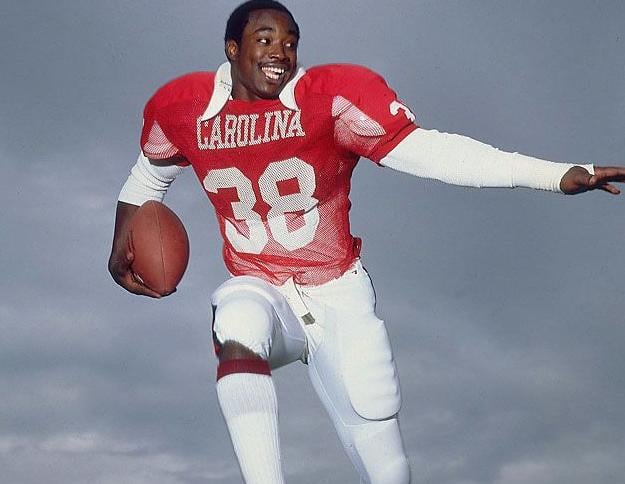





Homebrewcock
GCF Top Poster
[No message]
BB-38, USS Pennsylvania, in the drydock at Pearl after the attack, surrounded by the hulks of the Cassin and the Downes. Photo below shows the Pennsy leading the Colorado, Portland, and the Columbia (Go Gamecocks!) into the Lingayen Gulf in 1944.
,_USS_Cassin_(DD-372)_and_USS_Pennsylvania_(BB-38)_in_Dry_Dock_No._1_at_the_Pearl_Harbor_Naval_Shipyard,_7_December_1941_(306533).jpg/800px-USS_Downes_(DD-375),_USS_Cassin_(DD-372)_and_USS_Pennsylvania_(BB-38)_in_Dry_Dock_No._1_at_the_Pearl_Harbor_Naval_Shipyard,_7_December_1941_(306533).jpg)

,_USS_Cassin_(DD-372)_and_USS_Pennsylvania_(BB-38)_in_Dry_Dock_No._1_at_the_Pearl_Harbor_Naval_Shipyard,_7_December_1941_(306533).jpg/800px-USS_Downes_(DD-375),_USS_Cassin_(DD-372)_and_USS_Pennsylvania_(BB-38)_in_Dry_Dock_No._1_at_the_Pearl_Harbor_Naval_Shipyard,_7_December_1941_(306533).jpg)

38th Division - made up of national Guard soldiers primarily from Indiana, Ohio, Kentucky, Delaware, Michigan, and Tennessee.
https://en.wikipedia.org/wiki/38th_Infantry_Division_(United_States)

https://en.wikipedia.org/wiki/38th_Infantry_Division_(United_States)

The Lockheed P-38 Lightning. Known as the the "fork-tailed devil" to the Japanese. Below is the P-38 flown by the top ace of WW2, Major Dick Bong.



https://en.wikipedia.org/wiki/Richard_Bong


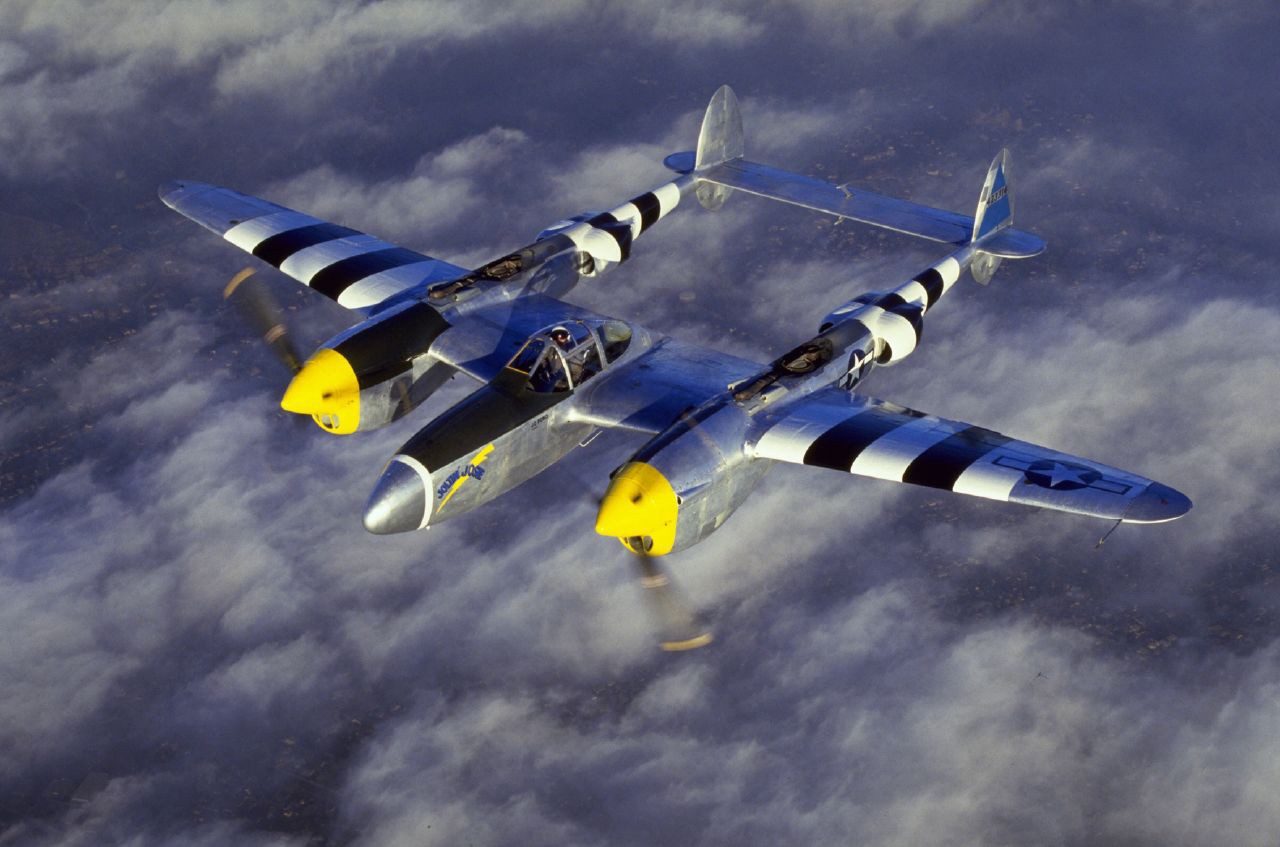

Richard Ira Bong (September 24, 1920 – August 6, 1945) was a United States Army Air Forces major and Medal of Honor recipient in World War II. He was one of the most decorated American fighter pilots and the country's top flying ace in the war, credited with shooting down 40 Japanese aircraft, all with the Lockheed P-38 Lightning fighter. He died in California while testing a Lockheed P-80 jet fighter shortly before the war ended.
United States Army Air Forces
Bong's ability as a fighter pilot was recognized while he was training in northern California. He was commissioned a second lieutenant and awarded his pilot wings on January 19, 1942. His first assignment was as an instructor (gunnery) pilot at Luke Field, Arizona, from January to May 1942. His first operational assignment was on May 6 to the 49th Fighter Squadron (FS), 14th Fighter Group at Hamilton Field, California, where he learned to fly the twin-engine Lockheed P-38 Lightning.
On June 12, 1942, Bong flew very low ("buzzed") over a house in nearby San Anselmo, the home of a pilot who had just been married. He was cited and temporarily grounded for breaking flying rules, along with three other P-38 pilots who had looped around the Golden Gate Bridge on the same day. For looping the Golden Gate Bridge, flying at a low level down Market Street in San Francisco, and blowing the clothes off of an Oakland woman's clothesline, Bong was reprimanded by General George C. Kenney, commanding officer of the Fourth Air Force, who told him, "If you didn't want to fly down Market Street, I wouldn't have you in my Air Force, but you are not to do it any more and I mean what I say." Kenney later wrote, "We needed kids like this lad."
In all subsequent accounts, Bong denied flying under the Golden Gate Bridge. Nevertheless, Bong was still grounded when the rest of his group was sent without him to England in July 1942. Bong then transferred to another Hamilton Field unit, 84th Fighter Squadron of the 78th Fighter Group. From there, Bong was sent to the Southwest Pacific Area.
On September 10, 1942, Lt. Bong was assigned to the 9th Fighter Squadron, which was flying P-40 Warhawks, based at Darwin, Australia. In November, while the squadron waited for delivery of the scarce P-38s, Bong and other 9th FS pilots were reassigned temporarily to fly missions and gain combat experience with the 39th Fighter Squadron, 35th Fighter Group, based in Port Moresby, New Guinea. On December 27, Bong claimed his initial aerial victory, shooting down a Mitsubishi A6M "Zero", and a Nakajima Ki-43 "Oscar" over Buna (during the Battle of Buna-Gona). For this action, Bong was awarded the Silver Star.
Bong rejoined the 9th FS, by then equipped with P-38s, in January 1943; the 49th FG was based at Schwimmer Field near Port Moresby. In April, he was promoted to first lieutenant. On July 26, Bong claimed four Japanese fighters over Lae, in an action that earned him the Distinguished Service Cross. In August, he was promoted to captain.
While on leave to the United States the following November and December, Bong met Marjorie Vattendahl at a Superior State Teachers' College homecoming event and began dating her.
After returning to the southwest Pacific in January 1944, he named his P-38 "Marge" and adorned the nose with her photo. On April 12, Captain Bong shot down his 26th and 27th Japanese aircraft, surpassing Eddie Rickenbacker's American record of 26 credited victories in World War I. Soon afterwards, he was promoted to major by General Kenney and dispatched to the United States to see General "Hap" Arnold, who gave him a leave.

https://en.wikipedia.org/wiki/Richard_Bong
https://en.wikipedia.org/wiki/Lockheed_P-38_Lightning#Charles_MacDonaldIsoroku Yamamoto
The Lightning figured in one of the most significant operations in the Pacific theater: the interception, on 18 April 1943, of Admiral Isoroku Yamamoto, the architect of Japan's naval strategy in the Pacific including the attack on Pearl Harbor. When American codebreakers found out that he was flying to Bougainville Island to conduct a front-line inspection, 16 P-38G Lightnings were sent on a long-range fighter-intercept mission, flying 435 miles (700 km) from Guadalcanal at heights of 10–50 ft (3.0–15.2 m) above the ocean to avoid detection. The Lightnings met Yamamoto's two Mitsubishi G4M "Betty" fast bomber transports and six escorting Zeros just as they arrived at the island. The first Betty crashed in the jungle and the second ditched near the coast. Two Zeros were also claimed by the American fighters with the loss of one P-38. Japanese search parties found Yamamoto's body at the jungle crash site the next day.


Last edited by a moderator:
USS Princeton, CV-37.
_underway_at_sea,_circa_1965_(NNAM.1996.488.060.030).jpg/1280px-USS_Princeton_(LPH-5)_underway_at_sea,_circa_1965_(NNAM.1996.488.060.030).jpg)
_underway_at_sea,_circa_1965_(NNAM.1996.488.060.030).jpg/1280px-USS_Princeton_(LPH-5)_underway_at_sea,_circa_1965_(NNAM.1996.488.060.030).jpg)
https://en.wikipedia.org/wiki/USS_Princeton_(CV-37)USS Princeton (CV/CVA/CVS-37, LPH-5) was one of 24 Essex-class aircraft carriers built during and shortly after World War II for the United States Navy. The ship was the fifth US Navy ship to bear the name, and was named for the Revolutionary War Battle of Princeton. Princeton was commissioned in November 1945, too late to serve in World War II, but saw extensive service in the Korean War, in which she earned eight battle stars, and the Vietnam War. She was reclassified in the early 1950s as an attack carrier (CVA), then as an Antisubmarine Aircraft Carrier (CVS), and finally as an amphibious assault ship (LPH), carrying helicopters and Marines. One of her last missions was to serve as the prime recovery ship for the Apollo 10 space mission.
Although she was extensively modified internally as part of her conversion to an LPH, external modifications were minor, so throughout her career Princeton retained the classic appearance of a World War II Essex-class ship.
Last edited by a moderator:
USS Tuscaloosa, CA-37.
_-_19-N-14733.jpg/1280px-USS_Tuscaloosa_(CA-37)_-_19-N-14733.jpg)
_-_19-N-14733.jpg/1280px-USS_Tuscaloosa_(CA-37)_-_19-N-14733.jpg)
https://en.wikipedia.org/wiki/USS_Tuscaloosa_(CA-37)USS Tuscaloosa (CA-37) was a New Orleans-class cruiser of the U.S. Navy. Commissioned in 1934, she spent most of her career in the Atlantic and Caribbean, participating in several European wartime operations. In early 1945, she transferred to the Pacific and assisted in shore bombardment of Iwo Jima and Okinawa. She earned 7 battle stars for her service in World War II. Never damaged in battle, she led a charmed life compared to her six sister ships, three of which were sunk and the other three heavily damaged.
37th Division - made up of National Guard soldiers from Ohio
https://en.wikipedia.org/wiki/37th_Infantry_Division_(United_States)

https://en.wikipedia.org/wiki/37th_Infantry_Division_(United_States)

USS Fanning, DD-37.
,_in_port,_probably_at_Queenstown,_Ireland.jpg)
Fanning was the prize-master on the brig Angelica. In the early days of the U. S. Navy, ship captains received a calculated monetary commission based on the value of the ships they captured. The prize money was then distributed among the officers and enlisted men of their ships. Hence the term "commissioned officer" used today as a reference to a tradition in the Navy's past. Men and women today simply receive the title of commissioned officers rather than being paid an actual commission on captured ships as in the early days.
The Bonhomme Richard engaging HMS Serapis during the Revolutionary War at the Battle of Flamborough Head.
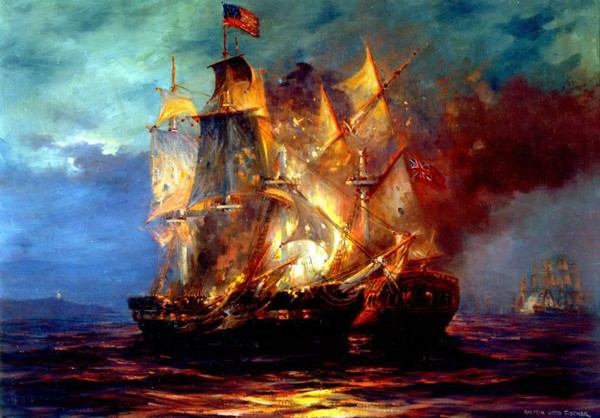
https://en.wikipedia.org/wiki/Battle_of_Flamborough_Head
The Fanning was a superlative ship named for a superlative individual.
,_in_port,_probably_at_Queenstown,_Ireland.jpg)
The Fanning was instrumental in developing and perfecting techniques that would eventually be known in the Navy as Underway Replenishment (UNREP). Everyone who has ever served in the Navy knows what that is.The first USS Fanning (DD-37) was a modified Paulding-class destroyer in the United States Navy during World War I and later in the United States Coast Guard, designated as CG-11. Her namesake was Nathaniel Fanning.
Pre-World War I
As war raged in Europe, Fanning intensified her preparations for any eventuality. When two German auxiliary cruisers visited Norfolk in September 1916, Fanning acted as part of their escort while they sailed in United States territorial waters. On 8 October, Fanning put out of Newport, Rhode Island, to search for the crews of ships sunk not far from Nantucket Light Ship by the German submarine U-58. The destroyer recovered six survivors and landed them at Newport, Rhode Island the next day. The presence of U-58 led to the speculation that a secret German submarine base might exist in the Long Island Sound—Block Island Sound area; Fanning searched from 12 to 14 October for evidence of such a base but found nothing, and returned to her regular operating schedule.
During the latter half of October 1916, Fanning and the fuel ship Jason conducted experiments to develop methods of oiling at sea, a technique which has since given the United States Navy unbounded mobility and sea-keeping qualities.
https://en.wikipedia.org/wiki/USS_Fanning_(DD-37)World War I
Based on Queenstown, Ireland, Fanning and her sister destroyers patrolled the eastern Atlantic, escorting convoys and rescuing survivors of sunken merchantmen. At 1615 on 17 November 1917, Coxswain Daniel David Loomis sighted the periscope of U-58, and the Officer of the Deck Lieutenant Walter Owen Henry ordered the destroyer to attack. Fanning's first depth charge pattern scored, and as destroyer Nicholson joined the action, the submarine broke surface, her crew pouring out on deck, hands raised in surrender. The depth charge had hit near the submarines diving planes, forcing the submarine to surface, and also knocked out the main generator aboard Fanning. Fanning maneuvered to pick up the prisoners as the damaged submarine sank, the first of two U-boats to fall victim to US Navy destroyers in World War I. Coxswain Daniel David Loomis and Lieutenant Walter Owen Henry both received the Navy Cross for this action.
Fanning continued escort and patrol duty for the duration of the war. Though she made numerous submarine contacts, all of her attacks were inconclusive. On many occasions, she went to the aid of torpedoed ships, rescuing survivors and carrying them into port. On 8 October 1918, she picked up a total of 103 survivors, 25 from a merchantman and 78 from the Dupetit-Thouars.
Fanning passed in review before President Woodrow Wilson on board the transport George Washington in Brest Harbor on 13 December, then remained at Brest until March of the following year.
https://en.wikipedia.org/wiki/Nathaniel_FanningNathaniel Fanning (31 May 1755 – 30 September 1805) was an officer in the Continental Navy and later the United States Navy, who served aboard Bonhomme Richard during its 1779 battle with HMS Serapis.
Fanning was born in Stonington, Connecticut, and was the eldest son of Gilbert Fanning and Huldah Palmer. His father was a sea merchant who was one of the largest provisioners of General George Washington's army during the American Revolution.
On May 26, 1778, Fanning embarked from Boston, Massachusetts, aboard the brig Angelica as a prize-master under the command of Captain William Denison in a cruise against the British. On May 31, Angelica was captured by the British man-of-war Andromeda and blown up, with Fanning being made a prisoner. Aboard Andromeda was General William Howe, who was returning to England. By orders of General Howe, the Americans were confined to the hold and treated severely, being allowed but a half-pint of water per day per man, even though the heat was so unbearable that the men were obliged to strip off all their clothes.
On June 30, 1778, Andromeda reached Portsmouth, England, and Fanning was incarcerated at Forton prison. On July 2, 1779, Fanning was included in a prisoner exchange. He was marched to Gosport, then taken by cartel to Nantes, France. From there, he traveled to L'Orient, where, under the command of John Paul Jones, he agreed to serve as midshipman and private secretary aboard Bonhomme Richard.
On August 14, 1779, Bonhomme Richard set sail, and over the next month captured or destroyed at least 29 enemy vessels. On September 23, Bonhomme Richard famously fought the British frigate Serapis. During this engagement, Fanning served as captain of the main top. Most of his original group of men were killed, but he took a fresh party aloft and with them cleared Serapis' tops. When their yards locked the ships together, he led his men across to the British ship, where with hand grenades and mortars, they drove the British seamen from their stations. In recommending that Fanning be promoted, Jones said of him ". . . he was one cause among the prominent in obtaining the victory". Bonhomme Richard was destroyed during this battle, but the Americans sailed to Holland aboard Serapis.
Fanning continued to serve under Jones aboard his new ship Alliance and later Ariel. Fanning then served as second-in-command aboard the privateer Count de Guichen. On March 23, 1781, they set sail from Morlaix and for many weeks ransomed or sunk numerous enemy vessels. But on May 4, the privateer was captured by Aurora and Fanning was again made prisoner, but paroled after six weeks.
On December 3, 1781, Fanning sailed from Ostend aboard Eclipse and had another productive cruise, returning to Dunkirk on March 6, 1782. While Eclipse was being refitted, Fanning made two trips to London, once as a spy and once to deliver peace proposals from the court of French King Louis XVI. On June 6, Eclipse left for the coast of Scotland under the command of Fanning. On August 11, Eclipse was chased by Jupiter, said to be the fastest ship in the Royal Navy. To escape Jupiter, Fanning ordered Eclipse to pass directly through the middle of the British Channel Fleet in broad daylight. To evade capture, he hoisted English colors and when hailed, answered that the ship was His Majesty's cutter Surprise.
Two days later, Fanning was wounded in the left leg by a musket ball while capturing Lord Howe. He sailed for Dunkirk and spent several weeks recovering. In October 1782, he was commissioned as lieutenant in the French Navy. On October 23, he sailed from Dunkirk in command of the privateer Ranger, but it was captured by a British cutter. Fanning was promptly exchanged, but his crew members, being Irish, were all executed as traitors.
Returning to Dunkirk, Fanning set sail again on November 14, but was captured a fourth time by the British frigate Belle Poule. Fanning was placed in chains, and abused by the crew. He was rescued when his captors' ship was, in turn, captured by the French Navy. Learning that a peace treaty was imminent, Fanning attempted to launch yet another expedition against the British, but was unable to set sail before further privateering was prohibited.
Fanning returned to the United States and, on December 5, 1804, was commissioned a lieutenant in the U. S. Navy. While stationed in Charleston, South Carolina, Lieutenant Fanning died of yellow fever on September 30, 1805, while commanding Gunboat Number 1.
During the American Revolution, two of Fanning's brothers, Gilbert and Thomas, were captured while serving aboard an American privateer and held prisoner on the prison hulk HMS Jersey, where Gilbert died. Fanning was also the brother of explorer Edmund Fanning and a first cousin of celebrated attorney John Wickham.
Fanning was the prize-master on the brig Angelica. In the early days of the U. S. Navy, ship captains received a calculated monetary commission based on the value of the ships they captured. The prize money was then distributed among the officers and enlisted men of their ships. Hence the term "commissioned officer" used today as a reference to a tradition in the Navy's past. Men and women today simply receive the title of commissioned officers rather than being paid an actual commission on captured ships as in the early days.
The Bonhomme Richard engaging HMS Serapis during the Revolutionary War at the Battle of Flamborough Head.

https://en.wikipedia.org/wiki/Battle_of_Flamborough_Head
The Fanning was a superlative ship named for a superlative individual.
Last edited by a moderator:
USS Charles Lawrence, APD-37. Formerly DE-53.
_at_anchor_on_5_October_1943.jpg)
_at_anchor_on_5_October_1943.jpg)
https://en.wikipedia.org/wiki/USS_Charles_Lawrence_(DE-53)History
USS Charles Lawrence was named in honor of Ordnanceman Charles Lawrence (1916–1941), who was killed in action during the Japanese attack on Pearl Harbor 7 December 1941.
Charles Lawrence was laid down on 1 August 1942 at the Bethlehem-Hingham Shipyard, Inc., in Hingham, Massachusetts, launched on 16 February 1943, sponsored by Mrs. S. Lawrence, and commissioned on 31 May 1943, with Lieutenant Commander L. S. Kintberger in command.
Battle of the Atlantic
Assigned first to escort central Atlantic convoys of tankers between Norfolk, Virginia, and Casablanca, Charles Lawrence made one such voyage between 16 August and 24 September 1943. She was then transferred to the high-speed tanker convoys formed at New York City from ships which had sailed independently up the east coast, now swept of the submarine menace, from West Indian oil ports. Between 13 October 1943 and 23 September 1944, Charles Lawrence escorted eight such convoys to Northern Ireland, returning with the tankers in ballast to New York. This flow of the fuel of war was so safely guarded by her group that only one tanker was lost in any of their passages. Along with the constant alertness against submarine attack, Charles Lawrence had to maintain a high standard of seamanship to keep the seas in all kinds of weather. At one time, during what was known as the "Christmas Hurricane" of 1943, the ships of her convoy were virtually hove-to for 20 hours.
Charles Lawrence was reclassified APD-37 on 23 October 1944, and was converted to a high speed transport in New York City, and became the name ship of the class.
BB-37, USS Oklahoma, during her salvage effort after being sunk and capsized at Pearl Harbor.
By early 1942, it was determined that Oklahoma could be salvaged and that she was a navigational hazard, having rolled into the harbor's navigational channel. Even though it was cost-prohibitive to do so, the job of salvaging Oklahoma commenced on 15 July 1942, under the immediate command of Captain F. H. Whitaker, and a team from the Pearl Harbor Naval Shipyard.[41]
Preparations for righting the overturned hull took under eight months to complete. Air was pumped into interior chambers and improvised airlocks built into the ship, forcing 20,000 tonnes (19,684 long tons; 22,046 short tons) of water out of the ship through the torpedo holes. Four thousand five hundred tonnes (4,429 long tons; 4,960 short tons) of coral soil were deposited in front of her bow to prevent sliding and two barges were posted on either end of the ship to control the ship's rising.[42]
Twenty-one derricks were attached to the upturned hull; each carried high-tensile steel cables that were connected to hydraulic winching machines ashore. The righting (parbuckling) operation began on 8 March, and was completed by 16 June 1943. Teams of naval specialists then entered the previously submerged ship to remove human remains. Cofferdams were then placed around the hull to allow basic repairs to be undertaken so that the ship could be refloated; this work was completed by November. On 28 December, Oklahoma was towed into drydock No. 2, at the Pearl Harbor Naval Shipyard. Once in the dock, her main guns, machinery, remaining ammunition, and stores were removed. The severest structural damage on the hull was also repaired to make the ship watertight.
Oklahoma was decommissioned on 1 September 1944, and all remaining armaments and superstructure were then removed. She was then put up for auction at the Brooklyn Navy Yard on 26 November 1946, with her engines, boilers, turbo generators, steering units and about 24,000 tonnes (23,621 long tons; 26,455 short tons) of structural steel deemed salvageable. She was sold to Moore Drydock Co. of Oakland, California for $46,127.

By early 1942, it was determined that Oklahoma could be salvaged and that she was a navigational hazard, having rolled into the harbor's navigational channel. Even though it was cost-prohibitive to do so, the job of salvaging Oklahoma commenced on 15 July 1942, under the immediate command of Captain F. H. Whitaker, and a team from the Pearl Harbor Naval Shipyard.[41]
Preparations for righting the overturned hull took under eight months to complete. Air was pumped into interior chambers and improvised airlocks built into the ship, forcing 20,000 tonnes (19,684 long tons; 22,046 short tons) of water out of the ship through the torpedo holes. Four thousand five hundred tonnes (4,429 long tons; 4,960 short tons) of coral soil were deposited in front of her bow to prevent sliding and two barges were posted on either end of the ship to control the ship's rising.[42]
Twenty-one derricks were attached to the upturned hull; each carried high-tensile steel cables that were connected to hydraulic winching machines ashore. The righting (parbuckling) operation began on 8 March, and was completed by 16 June 1943. Teams of naval specialists then entered the previously submerged ship to remove human remains. Cofferdams were then placed around the hull to allow basic repairs to be undertaken so that the ship could be refloated; this work was completed by November. On 28 December, Oklahoma was towed into drydock No. 2, at the Pearl Harbor Naval Shipyard. Once in the dock, her main guns, machinery, remaining ammunition, and stores were removed. The severest structural damage on the hull was also repaired to make the ship watertight.
Oklahoma was decommissioned on 1 September 1944, and all remaining armaments and superstructure were then removed. She was then put up for auction at the Brooklyn Navy Yard on 26 November 1946, with her engines, boilers, turbo generators, steering units and about 24,000 tonnes (23,621 long tons; 26,455 short tons) of structural steel deemed salvageable. She was sold to Moore Drydock Co. of Oakland, California for $46,127.



